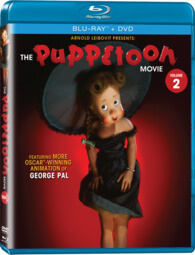Review: ‘The Puppetoon Movie’ Volume 2
The end of 2020 saw the official release of The Puppetoon Movie Volume 2, the long-awaited follow-up to the 1987 anthology collection of the work of stop-motion pioneer George Pal. Producer Arnold Leibovit worked with Paramount Pictures for this immaculately restored collection, which includes several long-lost Pal films from Europe as well as rarely-seen 2D cel animations from the 30s. With the release of Volume 2, Skwigly’s Laura-Beth takes a look back at the original film collection that started it all and what this new compilation brings to the table.
George Pal is a name you will hopefully be aware of; on the offchance that you’re not, Pal was a prolific, Hungarian-born animator and director whose vast output included some of the first, pioneering forays into sci-fi film. His ‘Puppetoons’ (sometime also referred to as ‘Madcap Models’) are often hailed as the earliest representations of replacement animation, in which the face, limbs or entire puppet were replaced frame by frame. Largely made of wood, but sometimes also metal and even glass, Pal’s work revolutionised the potential of puppet or stop-motion based animation processes.
 Volume 1 included multiple George Pal related documentaries, individual short productions and other interesting archival footage. The Puppetoon Movie itself, originally released in 1987, uses a somewhat unique framing device that bookends what is essentially a collection of his short films and advertisements, showcasing the far-reaching influence on the stop-motion and practical VFX industries Pal’s work had, with many figures of note discussing and giving thanks to Pal for his legacy and ingenuity.
Volume 1 included multiple George Pal related documentaries, individual short productions and other interesting archival footage. The Puppetoon Movie itself, originally released in 1987, uses a somewhat unique framing device that bookends what is essentially a collection of his short films and advertisements, showcasing the far-reaching influence on the stop-motion and practical VFX industries Pal’s work had, with many figures of note discussing and giving thanks to Pal for his legacy and ingenuity.
The Puppetoon Movie: Volume 2 adds additional films to the extensive library of Pal’s work. Presented in meticulously-restored high definition it sits well with the first volume and offers further material to the home audience. Although the overall quantity of special features is reduced, anyone with an enthusiasm for Pal or stop-motion history would still most likely want to have this as an addition to the larger selection available in Volume 1. Either way it is an impressive feat to have brought together these shorts, some of which having been hidden or lost except for in private collections – as with Wilber the Lion (1946) – or otherwise vaulted away in large studio libraries. There are some extras included with these films that focus predominantly on short production vignettes on some of Pal’s films, as well as The Puppetoon Movie.
There has also been an effort – in the form of a warning at the start of the film as well as in accompanying leaflet – to draw attention to the occasionally problematic use of stereotypes in some of Pal’s works, appropriately framing them as a product of the time and providing further information and contextualisation since their initial release.
My only real critical note would be the slightly arbitrary way in which the separate short films themselves are presented across the two volumes. There doesn’t seem to be any thematic or chronological link or order to the selection and, while the set comes with an option to watch the films individually or all at once, I would have personally found categorisation by date or production type (eg. commercials, Pal’s Jasper series etc) useful. However as a collection of films from Pal’s immense career you can’t get much better than this. These two companion collections clearly represents a huge and enduring part of Pal (and, by association, Leibovit)’s career, shining a well-focused light on the work of a tremendous figure in the history of animation production.
The real value in both these discs is the access consumers now have to such high quality copies of Pal’s work; the effort and time to secure the rights, find copies, reach out to both specialist collectors and studios is impressive in and of itself. To see such a library of stunning work revitalised and repaired to its former glory is something to be celebrated and a great resource for students, animation enthusiasts and researchers alike.
Puppetoons (High Definition)
- Dipsy Gypsy (1940)
- Radio Valve Revolution (1934)
- Ali Baba and the Forty Thieves (1935)
- A Hatful of Dreams (1944)
- Rescue Brigade (1937)
- In Lamp Light Land (1935)
- Jasper and the Choo-Choo (1942)
- Love On The Range (1938)
- The Gay Knighties (1941)
- Two Gun Rusty (1944)
- How An Advertising Poster Came About (1938)
- Jasper Goes Hunting (1944)
- Sky Pirates (1938)
- Jasper’s Close Shave (1945)
- The Ship of the Ether (1934)
- Good Night Rusty (1943)
- Wilbur the Lion (1946)
- Jasper Tell (1944)
Extras (Standard Definition)
- This is Oil, No.1: Prospecting for Petroleum (1946) Shell Oil Company Inc.
- Trailers From Hell: Arnold Leibovit on The Puppetoon Movie
- Trailers From Hell: Arnold Leibovit on The Fantasy Film Worlds of George Pal
- The Puppetoon Movie Speedy Alka-Seltzer Promo Miles Laboratory
- The Puppetoon Movie Montage
- Full Production and Donor Credits
Includes 6-Panel Color Booklet, Liner Notes by Arnold Leibovit
The Puppetoons Movie Volume 2 is available to UK customers via eBay (UK) and from puppetoon.net (US/rest of the world)

